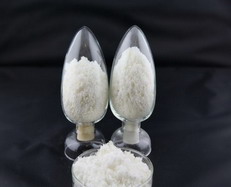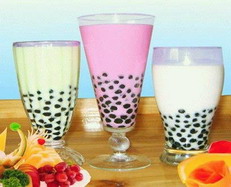CMC



Carboxymethyl cellulose (CMC) or cellulose gum is a cellulose derivative with carboxymethyl groups (-CH2-COOH) bound to some of the hydroxyl groups of the glucopyranose monomers that make up the cellulose backbone. It is often used asits sodium salt, sodium carboxymethyl cellulose.
CMC is synthesized by the alkali-catalyzed reaction of cellulose with chloroacetic acid. The polar (organic acid) carboxyl groups render the cellulose soluble and chemically reactive.
The functional properties of CMC depend on the degree of substitution of the cellulose structure (i.e., how many of the hydroxyl groups have taken part in the substitution reaction), as well as the chain length of the cellulose backbone structure and the degree of clustering of the carboxymethyl substituents.
Uses CMC is used in food science as a viscosity modifier or thickener, and to stabilize emulsions in various products including ice cream.
As a food additive, it has E number E466. It is also a constituent of manynon-food products, such as K-Y Jelly, toothpaste, laxatives, diet pills,water-based paints, detergents, textile sizing and various paper products. It is used primarily because it has high viscosity, is non-toxic, and is hypoallergenic.
In laundry detergents it is used as a soil suspension polymer designed to deposit onto cotton and other cellulosic fabrics creating anegatively charged barrier to soils in the wash solution.
CMC is used as alubricant in non-volatile eye drops (artificial tears). Sometimes it is methylcellulose (MC) which is used, but its non-polar methyl groups (-CH3) do not addany solubility or chemical reactivity to the base cellulose.
Following the initial reaction the resultant mixture produces approximately 60% CMC plus 40% salts (sodium chloride and sodium glycolate).This product is the so-called Technical CMC which is used in detergents. A further purification process is used to remove these salts to produce pure CMC which is used for food, pharmaceutical and dentifrice (toothpaste) applications. An intermediate "semi-purified" grade is also produced, typically used in paper applications.
CMC is used in pharmaceuticals as a thickening agent,is also used in the oil drilling industry as an ingredient of drilling mud,where it acts as a viscosity modifier and water retention agent.
Poly-anioniccellulose or PAC is derived from cellulose and is also used in oil field practice. CMC is definitely a Carboxylic Acid, where PAC is Ether.CMC and PAC,although they are manufactured from same raw materials (cellulose, amount and type of materials used leads different final products. The first and the leading difference between CMC and PAC exist in radicalization step.CarboxyMethyl Cellulose (CMC) is both chemically and physically distinguished from Polyanionic Cellulose.
Insoluble microgranular carboxymethyl cellulose is used as acation-exchange resin in ion-exchange chromatography for purification of Proteins. Presumably the level of derivatization is much lower so that the solubility properties of microgranular cellulose are retained while adding sufficient negative charged carboxylate groups to bind positively charged proteins.
CMC is also used in ice packs to form a eutectic mixture resulting in a lower freezing point and therefore more cooling capacity than ice.
Aqueous solutions CMC have also been used to disperse carbonnanotubes. It is thought that the long CMC molecules wrap around the nanotubes,allowing them to be dispersed in water.
If you need product Data sheet,pls contact us freely.
sales@sinowells.com